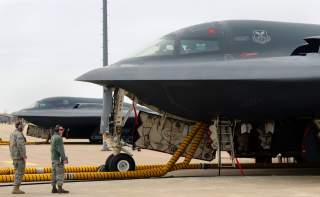Why the B-21 Stealth Bomber Could Also Fight Other Planes
A necessary capability?
Key point: The B-21 might need to shoot down enemy fighters to reach its bombing targets.
The U.S. Air Force’s new B-21 Raider stealth bomber could fly as early as 2021. And at least one Air Force general believes the new Northrop Grumman-made bomber could gain air-to-air capabilities in order to help it fight its way to its target.
There is some precedent for a bomber aircraft with a secondary air-to-air mission. In the late 1980s and early 1990s, the U.S. Navy paid General Dynamics and McDonnell Douglas billions of dollars to develop the A-12 Avenger II, a stealthy, carrier-launched medium bomber that was supposed to replace the Navy’s A-6 Intruders.
The A-12 was designed to carry two AIM-120 medium-range air-to-air missiles in addition to air-to-ground weaponry. But the U.S. Defense Department canceled the A-12 in 1991.
What went wrong? For one, the world changed -- and the secrecy surrounding the A-12 didn’t help either, according to James Stevenson, former editor of the Navy Fighter Weapons School’s Topgun Journal.
“After the Berlin Wall fell in November 1989, pressure for a ‘peace dividend’ increased,” Stevenson wrote.
In July 1990, one month before Iraq invaded Kuwait, Secretary of Defense Dick Cheney asked Congress for more A-12 money, but his request was rebuffed — an indication that the military budget decline was serious.
After Iraq invaded Kuwait, the budgeteers had to scramble for even more money. This fight for funds combined with the impending military action guaranteed that some programs would be radically slowed, reduced or eliminated.
The A-12 ended up as one of those terminated programs.
Cheney withdrew his support for the A-12 contract on Jan. 5, 1991, freeing more than $500 million for the impending war effort that began 10 days later. On the other hand, the F-22 squeaked through, even though the Air Force did not procure its original requirement of 750 F-22s. It eventually managed to squeeze 187 of them out of the budget.
In this case, when black and gray programs competed, the gray program — a lighter shade at that — survived in Darwinian fashion. Even though the A-12 was predicted to cost much less, Congress bankrolled the F-22 while the Navy watched in tears as its A-12 program was carted away.
And since the A-12 was secret, the branch couldn’t mount a public defense.
Which is not to say the A-12 program was in good shape otherwise, as David Montgomery explained in Air Force magazine in 1991. In fact, workers were having a hard time building the prototypes.
“The biggest problem, say officials, stemmed from the difficulties of creating and applying highly advanced composite material in the radar-evading stealth plane,” Montgomery wrote.
The two contractors had inadequate experience with this material to carry out the project smoothly and with a minimum of delay.
Evident mutual suspicion between the two contractors compounded the problem. One Pentagon analyst who studied the issue said the two A-12 contractors appeared loath to share sensitive technology to further the A-12 program. The reason: They were competitors on another project -- the program to build the Air Force's Advanced Tactical Fighter.
"There were technologies that could have helped in the overall [A-12] effort, but they weren't willing to share those," said the analyst. "If you have a technological advantage, how willing are you to share that if ... it could help you in some other program?"
An overly ambitious schedule exacerbated the problem. Under the original timetable, the contractors planned first flight for June 17,1990. They mapped out a design-to-assembly schedule of only nine months, far shorter than the fourteen months normally allotted for such an effort.
Workers in top-secret areas of plants operated by General Dynamics in Fort Worth, Texas, and by McDonnell Douglas in Saint Louis, Missouri, would spend four and a half months on subassembly. Sections would be shipped to Tulsa, Oklahoma, for final assembly.
According to the report, the manufacturers were only feeling their way along. They lacked proper tooling, missed key target dates at various steps in the development process, and were forced to issue "stop work orders" because of engineering problems. Delays in the arrival of parts further delayed production.
By contrast, the Air Force insists that B-21 development is proceeding without any major complications. Of course, the B-21 program also is highly secret, meaning it’s impossible for outsiders to verify the Air Force’s sanguine claims.
But if the B-21 does fly in 2021, as planned and ends up including the air-to-air capabilities that have been proposed, it could finally fulfill the A-12’s multi-role promise from nearly 30 years ago.
David Axe serves as Defense Editor of the National Interest. He is the author of the graphic novels War Fix, War Is Boring and Machete Squad. This first appeared in September 2019.
Image: Reuters.

